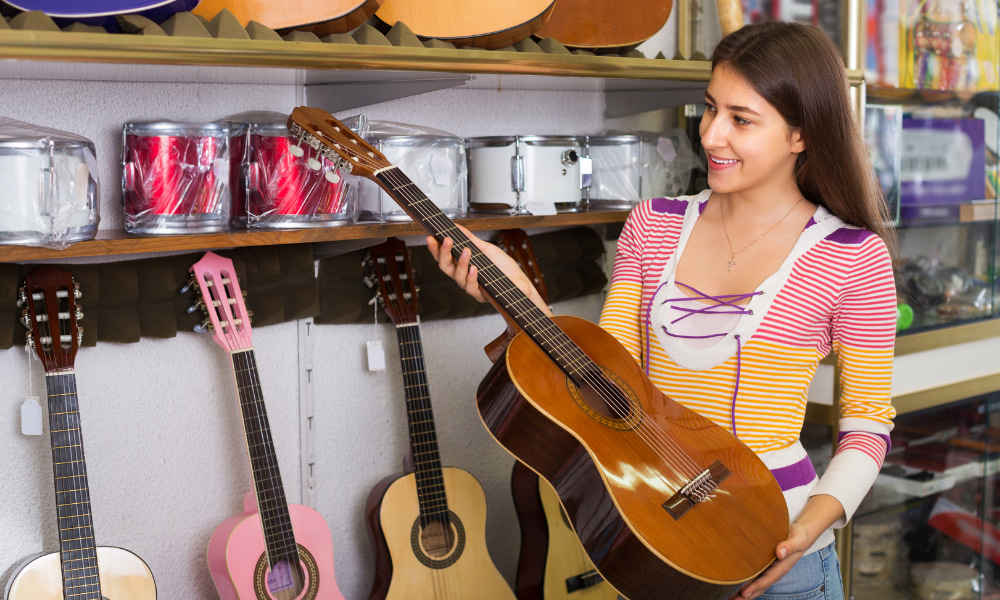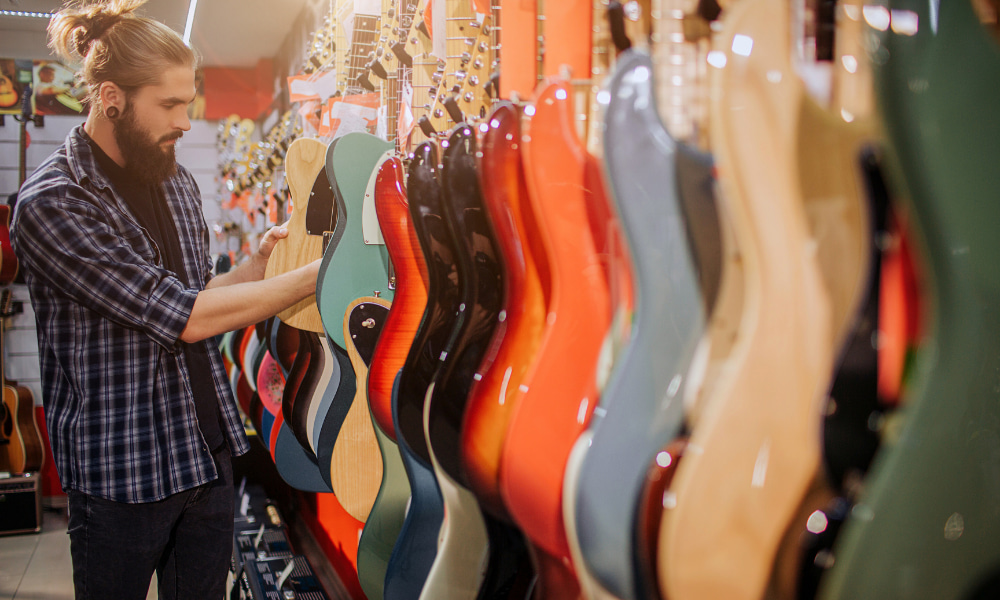It’s never too late to take up a new skill or hobby, and there are many benefits to learning how to play guitar. Some of the more well-known benefits include:
- Increased cognitive function
- Creative encouragement
- Reduced Stress
And that’s just the start. Plus, all of the above will have lifelong benefits.
The instrument you choose to learn should inspire you to put in the necessary work because even trained musicians have a hard time mastering a new musical craft. While learning to play a new instrument is exciting, it’s important to do your research and take the proper steps to give yourself the best chance at success.
In addition to taking guitar lessons from a trained music instructor, one of the most important steps in your musical journey is shopping for your beginner guitar. Here are a few helpful things to consider to make sure you choose the best guitar for you:
1. Buying New vs. Used
As you’re browsing through the music store for your first guitar, it’s important to understand the advantages and disadvantages of both new and used options according to your goals and budget.
Pros and Cons of Used Guitars:
Used guitars can be a great option for beginner guitarists because they’re typically more affordable than buying new. This allows you to get a basic feel for playing the instrument, then decide what you want and need in an instrument as you learn. You can always upgrade to a higher level or different guitar style later on if you feel so inclined.
On the other hand, used guitars can come with damage or wear and tear that may decrease their functionality and worth. Before purchasing a used instrument, verify that you’re buying from a trusted source. If you’re not certain about the music store’s credibility, inspect the guitar for visible problems prior to purchase and confirm it still has fully functioning tuning keys, strings, and other physical elements.
Pros and Cons of New Guitars:
New guitars feature state-of-the-art technology and can be customized to fit your needs and style. In addition, they typically come with a manufacturer’s warranty to cover some potential problems. If you know exactly what you’re looking for, buying a new guitar may be a smart investment. With proper care and maintenance, your guitar will last decades.
If you’re unsure about the style or brand of guitar you’re looking for, buying new may not be the best option for you. Additionally, if you’re shopping for a young student that will grow out of their current guitar size, it may be financially prudent to rent a guitar or buy used until they’re ready for a full size or long-term guitar.
2. Finding the Right Size
While it may be tempting to purchase a full-size, high-end guitar for your younger player to grow into, attempting to learn and practice on the wrong size instrument can make the training process much more difficult and impact playability.

Guitars come in three main sizes:
- Half guitar — 34 inches in length and typically used by five to seven-year-olds
- Three-quarter — 36 inches long and work well for most seven to ten-year-olds
- Full-size — 40 inches in length and suitable for all other guitarists
Length isn’t the only difference between the three sizes, as they also have varying fretboard distancing and guitar neck widths. An expert can help you make sure you’re purchasing the right size and style for your needs.
3. Choosing the Right Type of Guitar
It’s easy to become overwhelmed with all the options while shopping for your first guitar. There are so many questions, like:
- Nylon strings or steel strings?
- Fender or Yamaha?
- And of course, the most commonly asked question, acoustic or electric?
Deciding which guitar to buy prior to shopping will narrow the scope of options considerably. The two most popular types have very different sounds and musical characteristics. They’re the same instrument and the skills you learn using one type can be translated to the other, though, so the guitar you choose should inspire and motivate you throughout your learning experience. Consider the music you typically listen to, bands you love, and musical genres you ultimately want to play as you make a decision.
Here are some more facts about the two basic types of guitar:
Acoustic Guitars: Classic & Bright Sound
Acoustic and classical guitars are commonly associated with country, bluegrass, and indie alternative music, but their rich sound is utilized in almost every genre. They produce a full sound all on their own, which means you don’t necessarily need to buy electric amps and other accessories. All you need is your guitar and maybe a tuner.
One disadvantage to acoustic guitars is that they generally require thicker strings, which can make it more difficult for beginners and young guitarists to clearly strum chords. This obstacle is easily overcome after adjusting to the feel and playability of your new instrument, however.
Electric Guitars: Versatile & Easy to Play
If you’re more interested in playing modern music, electric guitars produce the sound and style used in a lot of popular songs in the pop and rock genres. They are also used in metal, country, R&B, and blues music, and are typically considered easier for beginners to learn and play than acoustic guitars because their necks are narrower. This makes the strings easier to press down while playing chords, and electric guitars are available in many body shapes to fit every player.

On the other hand, electric guitars require some additional accessories that acoustic options do not, such as an amplifier and headphones. Electric guitars are nearly silent when they’re played on their own, but their sound is incredibly versatile and bold once they’re connected to sound systems or practice amps.
Ready to Start Your Guitar Journey?
The instructors and staff at Sloan School of Music are dedicated to spreading excitement, inspiration, and knowledge about music, which is why we offer everything you need to become a great guitar player. Visit our online guitar shop to browse numerous well-known brands in vast price ranges and find the best guitar for you, plus shop for accessories like tuners, shoulder straps, extra strings, and finger picks.
Once you’ve chosen your instrument, you can enroll in your first guitar lesson with one of our highly-skilled instructors. Contact us today to learn more about how the Sloan School of Music can achieve your music dreams.








